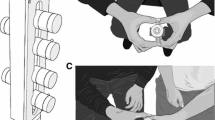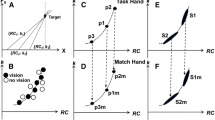Abstract
We examined how the digit forces adjust when a load force acting on a hand-held object continuously varies. The subjects were required to hold the handle still while a linearly increasing and then decreasing force was applied to the handle. The handle was constrained, such that it could only move up and down, and rotate about a horizontal axis. In addition, the moment arm of the thumb tangential force was 1.5 times the moment arm of the virtual finger (VF, an imagined finger with the mechanical action equal to that of the four fingers) force. Unlike the situation when there are equal moment arms, the experimental setup forced the subjects to choose between (a) sharing equally the increase in load force between the thumb and VF but generating a moment of tangential force, which had to be compensated by negatively co-varying the moment due to normal forces, or (b) sharing unequally the load force increase between the thumb and VF but preventing generation of a moment of tangential forces. We found that different subjects tended to use one of these two strategies. These findings suggest that the selection by the CNS of prehension synergies at the VF-thumb level with respect to the moment of force is non-obligatory and reflects individual subject preferences. This unequal sharing of the load by the tangential forces, in contrast to the previously observed equal sharing, suggests that the invariant feature of prehension may be a correlated increase in tangential forces rather than an equal increase.







Similar content being viewed by others
References
Arimoto S, Tahara K, Yamaguchi M, Nguyen P, Han M (2001) Principles of superposition for controlling pinch motions by means of robot fingers with soft tips. Robotica 19(1):21–28
Bernstein NA (1996) On dexterity and its development. In: Latash ML, Turvey MT (eds) Dexterity and its development. Erlbaum Publ., Mahwah, pp 3–244
de Freitas P, Krishnan V, Jaric S (2007) Force coordination in static manipulation tasks: effects of the change in direction and handedness. Exp Brain Res 183(4):487–497
Gao F, Latash ML, Zatsiorsky VM (2006) Maintaining rotational equilibrium during object manipulation: linear behavior of a highly non-linear system. Exp Brain Res 169(4):519–531
Gorniak SL, Zatsiorsky VM, Latash ML (2009) Hierarchical control of static prehension: II. Multi-digit synergies. Exp Brain Res 194(1):1–15
Hermsdörfer J, Blankenfeld H (2008) Grip force control of predictable external loads. Exp Brain Res 185(4):719–728
Johansson RS, Riso R, Häger C, Bäckström L (1992) Somatosensory control of precision grip during unpredictable pulling loads. I. Changes in load force amplitude. Exp Brain Res 89(1):181–191
Kang N, Shinohara M, Zatsiorsky VM, Latash ML (2004) Learning multi-finger synergies: an uncontrolled manifold analysis. Exp Brain Res 157:336–350
Kostyukov A (1998) Muscle hysteresis and movement control: a theoretical study. Neuroscience 83(1):303–320
Latash ML, Kang N, Patterson D (2002) Finger coordination in persons with Down syndrome: atypical patterns of coordination and the effects of practice. Exp Brain Res 146:345–355
Pataky TC, Latash ML, Zatsiorsky VM (2004) Tangential load sharing among fingers during prehension. Ergonomics 47(8):876–889
Santello M, Soechting JF (2000) Force synergies for multifingered grasping. Exp Brain Res 133(4):457–467
Shim JK, Latash ML, Zatsiorsky VM (2004) Finger coordination during moment production on a mechanically fixed object. Exp Brain Res 157(4):457–467
Shim JK, Latash ML, Zatsiorsky VM (2005a) Prehension synergies in three dimensions. J Neurophysiol 93(2):766–776
Shim JK, Latash ML, Zatsiorsky VM (2005b) Prehension synergies: trial-to-trial variability and principle of superposition during static prehension in three dimensions. J Neurophysiol 93(6):3649–3658
van Groeningen C, Nijhof EJ, Vermeule FM, Erkelens CJ (1999) Relation between torque history, firing frequency, decruitment levels and force balance in two flexors of the elbow. Exp Brain Res 129(4):592–604
Zatsiorsky (2002) Kinetics of human motion. Human Kinetics, Champaign, IL
Zatsiorsky VM, Gregory RW, Latash ML (2002) Force and torque production in static multifinger prehension: biomechanics and control. I. Biomechanics. Biol Cyber 87(1):50–57
Zatsiorsky VM, Gao F, Latash ML (2003) Prehension synergies: effects of object geometry and prescribed torques. Exp Brain Res 148(1):77–87
Zatsiorsky VM, Latash ML, Gao F, Shim JK (2004) The principle of superposition in human prehension. Robotica 22:231–234
Acknowledgments
The study was in part supported by NIH grants AG-018751, NS-035032, and AR-048563.
Author information
Authors and Affiliations
Corresponding author
Rights and permissions
About this article
Cite this article
Friedman, J., Latash, M.L. & Zatsiorsky, V.M. Prehension synergies: a study of digit force adjustments to the continuously varied load force exerted on a partially constrained hand-held object. Exp Brain Res 197, 1–13 (2009). https://doi.org/10.1007/s00221-009-1818-1
Received:
Accepted:
Published:
Issue Date:
DOI: https://doi.org/10.1007/s00221-009-1818-1




